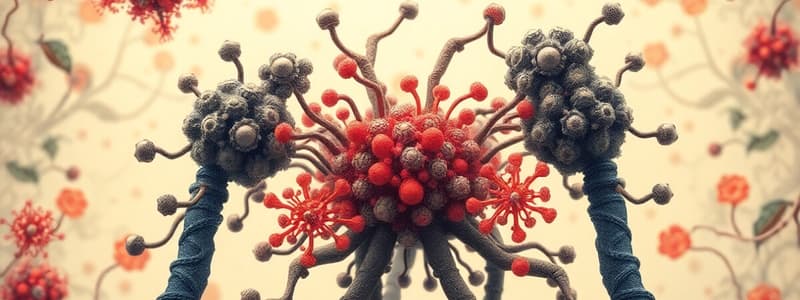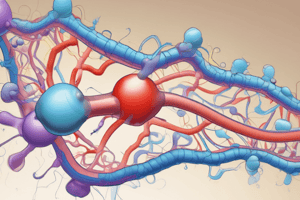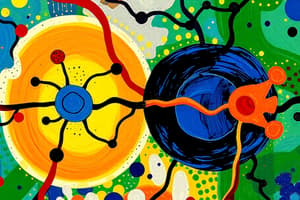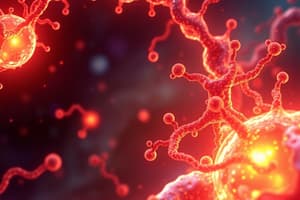Podcast
Questions and Answers
What characteristic distinguishes selective ligands from non-selective ligands?
What characteristic distinguishes selective ligands from non-selective ligands?
- Selective ligands act faster than non-selective ligands.
- Selective ligands have greater effectiveness at a target than non-selective ligands. (correct)
- Selective ligands have a wider range of targets.
- Selective ligands bind irreversibly to receptors.
Which receptor superfamily is the largest and includes 865 known human receptors?
Which receptor superfamily is the largest and includes 865 known human receptors?
- Nuclear receptors
- Ligand-gated ion channels
- Kinase linked receptors
- G-protein coupled receptors (correct)
Which type of G-protein activates phospholipase C to increase protein kinase C (PKC) and intracellular calcium concentrations?
Which type of G-protein activates phospholipase C to increase protein kinase C (PKC) and intracellular calcium concentrations?
- Go proteins
- Gq proteins (correct)
- Gs proteins
- Gi proteins
What is the function of Gi proteins in cellular communication?
What is the function of Gi proteins in cellular communication?
Which of the following examples is NOT a known type of GPCR?
Which of the following examples is NOT a known type of GPCR?
What is a drug defined as?
What is a drug defined as?
Which class of drug targets represents the highest percentage of identified targets?
Which class of drug targets represents the highest percentage of identified targets?
Which of the following correctly pairs a drug with its target and condition?
Which of the following correctly pairs a drug with its target and condition?
What does the mechanism of action describe in pharmacodynamics?
What does the mechanism of action describe in pharmacodynamics?
Which of the following is true regarding endogenous ligands?
Which of the following is true regarding endogenous ligands?
Which of the following drugs primarily targets receptors involved in treating asthma or COPD?
Which of the following drugs primarily targets receptors involved in treating asthma or COPD?
What type of drug is Metformin and what is its primary clinical use?
What type of drug is Metformin and what is its primary clinical use?
Which drug is associated with the treatment of thromboembolism and acts mainly as an enzyme?
Which drug is associated with the treatment of thromboembolism and acts mainly as an enzyme?
What is the primary role of drugs that alter the activity of molecules and cells within living organisms?
What is the primary role of drugs that alter the activity of molecules and cells within living organisms?
Which of the following options represents a dietary supplement mentioned in the content?
Which of the following options represents a dietary supplement mentioned in the content?
When discussing drug specificity, what is meant by 'specific ligands'?
When discussing drug specificity, what is meant by 'specific ligands'?
What potential outcome may arise from drugs affecting multiple targets in the body?
What potential outcome may arise from drugs affecting multiple targets in the body?
Which enzyme-targeting drug listed is known for its role in calcium metabolism?
Which enzyme-targeting drug listed is known for its role in calcium metabolism?
Which drug is recognized for its use in managing hypertension through receptor interaction?
Which drug is recognized for its use in managing hypertension through receptor interaction?
What type of molecule primarily functions as a chemical messenger within the human body, often targeted by drugs?
What type of molecule primarily functions as a chemical messenger within the human body, often targeted by drugs?
Flashcards are hidden until you start studying
Study Notes
Receptors
- Essential components of cellular communication
- Four major families:
- G-protein coupled receptors
- Ligand-gated ion channels
- Kinase linked receptors
- Nuclear receptors
- Often named after their ligands (endogenous or pharmacological)
G-protein Coupled Receptors
- Largest receptor family, with 865 known human GPCRs
- Ligand-activated receptors, consisting of a single polypeptide with 7 transmembrane domains
- Linked to intracellular effectors known as G-proteins
- Activate enzymatic signalling cascades, resulting in metabotropic responses, which are slow and long-lasting (induction takes over 100 milliseconds; initial effects last seconds to minutes)
Gs proteins
- Stimulate adenylate cyclase, increasing cAMP and PKA activity
Gi proteins
- Inhibit adenylate cyclase, decreasing cAMP and PKA activity
Gq proteins
- Activate phospholipase C, leading to increased PKC activity and intracellular calcium levels
Examples of GPCRs
- Muscarinic acetylcholine receptors: found in the CNS, lungs, and GI tract
- Adrenergic receptors: present in the heart, vasculature, lungs, and CNS
- Histamine receptors: located in the heart, vasculature, GI tract, and nociceptive pathways
- Prostaglandin receptors: involved in inflammation, GI function, and CNS activity
General Information
- Drugs target proteins; this is important to understand the mechanism of action of a drug
- Common drug targets include: receptors, enzymes, ion channels, and transporters
Enzymes
- Vital for metabolism, including:
- Regulation of metabolism
- Intracellular and intercellular signaling
- Gene activation and suppression
- Drug metabolism
Ion Channels
- Often selective for cations (K+, Na+, Ca2+) or anions (Cl-)
- Cation channels may be specific for one ion, or permeable to several
Voltage-gated Ion Channels
- Example: voltage-gated sodium channel (VGNaC)
- Closed at resting membrane potential (-70 mV)
- Depolarization of the membrane (-40 mV) causes the channel to open
Local Anesthetics
- Block the inside of the VGNaC pore, preventing Na+ flux
- Examples: lidocaine
Transporters ("Pumps")
- Move ions and small molecules across cell membranes
- May utilize electrochemical gradient or ATP hydrolysis
- Types include:
- Symporters: co-transport
- Antiporters: exchange
Selective Serotonin Reuptake Inhibitors (SSRIs)
- Inhibit the serotonin transporter (SERT), preventing reuptake of serotonin from the synapse
Tolerance
- Reduced drug effect over time
- Mechanisms include:
- Increased expression of proteins mediating opposite activity
- Receptor internalization by endocytosis
Withdrawal
- Symptoms experienced upon discontinuation of a drug
- Caused by the body's adaptation to the drug's presence
- Example: corticosteroids
- Suppress endogenous cortisol production
- Discontinuation leads to cortisol deficit
Summary of Drug Targets
- Drugs affect molecules to alter physiological activity
- Understanding the cellular and physiological systems targeted by drugs is crucial for comprehending pharmacology
Studying That Suits You
Use AI to generate personalized quizzes and flashcards to suit your learning preferences.




